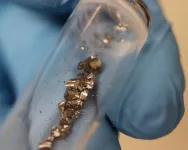Swimming at the mesoscale
FAU physicists discover simple propulsion mechanism for bodies in dense fluids.
2021-07-16
(Press-News.org) A team of researchers from Friedrich-Alexander-Universität Erlangen-Nürnberg (FAU), the University of Liège and the Helmholtz Institute Erlangen-Nürnberg for Renewable Energy have developed a microswimmer that appears to defy the laws of fluid dynamics: their model, consisting of two beads that are connected by a linear spring, is propelled by completely symmetrical oscillations. The Scallop theorem states that this cannot be achieved in fluid microsystems. The findings have now been published in the academic journal Physical Review Letters.
Scallops can swim in water by quickly clapping their shells together. They are large enough to still be able to move forwards through the moment of inertia while the scallop is opening its shell for the next stroke. However, the Scallop theorem applies more or less depending on the density and viscosity of the fluid: A swimmer that makes symmetrical or reciprocal forward or backward motions similar to the opening and closing of the scallop shell will not move an inch. 'Swimming through water is as tough for microscopic organisms as swimming through tar would be for humans,' says Dr. Maxime Hubert. 'This is why single-cell organisms have comparatively complex means of propulsion such as vibrating hairs or rotating flagella.'
Swimming at the mesoscale
Dr. Hubert is a postdoctoral researcher in Prof. Dr. Ana-Suncana Smith's group at the Institute of Theoretical Physics at FAU. Together with researchers at the University of Liège and the Helmholtz Institute Erlangen-Nürnberg for Renewable Energy, the FAU team has developed a swimmer which does not seem to be limited by the Scallop theorem: The simple model consists of a linear spring that connects two beads of different sizes. Although the spring expands and contracts symmetrically under time reversal, the microswimmer is still able to move through the fluid.ü
'We originally tested this principle using computer simulations,' says Maxime Hubert. 'We then built a functioning model'. In the practical experiment, the scientists placed two steel beads measuring just a few hundred micrometres in diameter on the surface of water contained in a Petri dish. The surface tension of the water represented the contraction of the spring and expansion in the opposite direction was achieved with a magnetic field which caused the microbeads to periodically repel other.
Vision: Swimming robots for transporting drugs
The swimmer is able to propel itself because the beads are of different sizes. Maxime Hubert says, 'The smaller bead reacts much faster to the spring force than the larger bead. This causes asymmetrical motion and the larger bead is pulled along with the smaller bead. We are therefore using the principle of inertia, with the difference that here we are concerned with the interaction between the bodies rather than the interaction between the bodies and water.'
Although the system won't win any prizes for speed - it moves forwards about a thousandth of its body length during each oscillation cycle - the sheer simplicity of its construction and mechanism is an important development. 'The principle that we have discovered could help us to construct tiny swimming robots,' says Maxime Hubert. 'One day they might be used to transport drugs through the blood to a precise location.'
INFORMATION:
ELSE PRESS RELEASES FROM THIS DATE:
2021-07-16
The UK government's latest pandemic plan involves recklessly exposing millions of people to the acute and long-term effects of mass infection, warn experts in The BMJ today.
A strategy that chooses mass infection in the young now over vaccination in order to achieve greater population immunity to protect the vulnerable in winter, is "unethical and unscientific" say Dr Deepti Gurdasani and colleagues.
Instead of allowing infections to rise, they urge the government to take urgent actions to inform and protect the public and prepare for autumn.
These include outlining a long-term strategy for pandemic control, keeping basic measures ...
2021-07-16
A team of researchers from Stanford University and the University of Leuven in Belgium has further elucidated an intriguing process that could be an important step toward a methanol fuel economy with abundant methane as the feedstock, an advance that could fundamentally change how the world uses natural gas.
Methanol - the simplest alcohol - is used to make various products, like paints and plastics, and as an additive to gasoline. Rich in hydrogen, methanol can drive new-age fuel cells that could yield significant environmental benefits.
If natural gas, of which methane ...
2021-07-16
In a new study from University of California San Diego School of Medicine, researchers have confirmed that patients taking statin medications had a 41 percent lower risk of in-hospital death from COVID-19. The findings were published July 15, 2021 in PLOS ONE and expand upon prior research conducted at UC San Diego Health in 2020.
Statins are commonly used to reduce blood cholesterol levels by blocking liver enzymes responsible for making cholesterol. They are widely prescribed: The Centers for Disease Control estimates that 93 percent of patients who use a cholesterol-lowering drug use a statin.
"When faced with this virus at the beginning of the pandemic, there was a lot of speculation ...
2021-07-15
Undeniably the shark movie to end all shark movies, the 1975 blockbuster, Jaws, not only smashed box office expectations, but forever changed the way we felt about going into the water - and how we think about sharks.
Now, more than 40 years (and 100+ shark movies) on, people's fear of sharks persists, with researchers at the University of South Australia concerned about the negative impact that shark movies are having on conservation efforts of this often-endangered animal.
In a world-first study, conservation psychology researchers, UniSA's Dr Briana Le Busque and Associate Professor Carla Litchfield have evaluated how sharks are portrayed in movies, finding that ...
2021-07-15
CHAMPAIGN, Ill. -- A new study shows that it is possible to use mechanical force to deliberately alter chemical reactions and increase chemical selectivity - a grand challenge of the field.
The study led by University of Illinois Urbana-Champaign researcher Jeffrey Moore and Stanford University chemist Todd Martinezz demonstrates how external mechanical forces alter atomic motions to manipulate reaction outcomes. The study findings are published in the journal Science.
"We think of chemical reactions as molecules moving on a surface of potential energy in the way hikers follow the contour map of mountains and valleys along a trail," said lead author Yun ...
2021-07-15
Scientists on the hunt for an unconventional kind of superconductor have produced the most compelling evidence to date that they've found one. In a pair of papers, researchers at the University of Maryland's (UMD) Quantum Materials Center (QMC) and colleagues have shown that uranium ditelluride (or UTe2 for short) displays many of the hallmarks of a topological superconductor--a material that may unlock new ways to build quantum computers and other futuristic devices.
"Nature can be wicked," says Johnpierre Paglione, a professor of physics at UMD, the director of QMC and senior author on one of the papers. "There could be other reasons we're seeing all this wacky stuff, but ...
2021-07-15
A new national study published in Public Health Nutrition on July 15 found that Americans experiencing food insufficiency were three times as likely to lack mental health support during the COVID-19 pandemic than those not experiencing food insufficiency.
The most extreme form of food insecurity, food insufficiency occurs when families do not have enough eat. Among a nationally representative sample of 68,611 adults who participated in the US Census Household Pulse Survey in October 2020, 11% reported food insufficiency. Of those, 24% also reported an unmet mental health need compared to 9% of food-sufficient adults.
"Hunger, exhaustion, and stress related to not getting enough food to eat may lead ...
2021-07-15
A national study published in the Journal of Pediatrics found that Emergency Department (ED) visits by youth for self-harm were nearly 40 percent higher in rural areas compared to urban settings. Strikingly, ED visits by youth for self-inflicted firearm injuries were three times more common in rural areas. Youth from rural areas presenting to the ED for suicidal ideation or self-harm also were more likely to need to be transferred to another hospital for care, which underscores the insufficient mental health resources in rural hospitals.
"Our study used pre-pandemic data, and we know that increased attention to youth mental health is even more pressing now everywhere, ...
2021-07-15
WINSTON-SALEM, NC, July 15, 2021 - Answering a charge from the National Science Board, the RegenMed Development Organization (ReMDO), through its RegeneratOR Workforce Development Initiative, has released the results of a national survey of regenerative medicine biomanufacturing knowledge, skills, and abilities needed for successful employment in the regenerative medicine field.
The National Science Board called for the creation of a skilled technical workforce driven by science and engineering in its 2019 report, "The Skilled Technical Workforce: Crafting America's Science and Engineering Enterprise."
"The RegeneratOR initiative ...
2021-07-15
A screening tool used to evaluate the need for endometrial cancer biopsies in women frequently misses the signs of this cancer in Black women, according to a new study released today in JAMA Oncology.
Dr. Kemi Doll, the lead researcher, and a gynecologic oncologist with the University of Washington School of Medicine, says that the results of the study suggest that the current non-invasive option of transvaginal ultrasound, or TVUS, to determine the appropriateness of a biopsy is not sufficiently accurate or racially equitable with regards to Black women.
"Black women have an over 90% higher mortality rate after diagnosis of endometrial cancer when compared with White women in the U.S.," Doll said. "This is a long-standing disparity ...
LAST 30 PRESS RELEASES:
[Press-News.org] Swimming at the mesoscale
FAU physicists discover simple propulsion mechanism for bodies in dense fluids.




